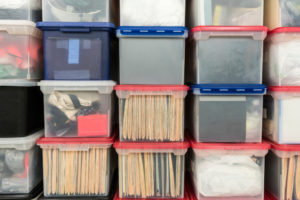Moving to a new city? Downsizing your home? Making a step to cohabitate with a partner? Simply clearing some clutter, but you’re not ready to get rid of those “extra” things? Thankfully, you can increase your available space by getting a storage unit.
Storage facilities can help you to make some space at home and keep the things you will want to have later. By planning ahead, you’ll make sure you can easily keep track of what’s in your storage unit, and easily access those things when you need them. We’ve made a list of our favorite tips for organizing your storage unit.
Keep an Inventory List
When it comes to putting your things in storage, it can be difficult to keep track of everything. Whether you have it there for a month or a year, you’re bound to forget just what you held onto. Large pieces that don’t fit in boxes will be a bit easier to remember and spot when you access your storage unit. As you pile smaller items into boxes, do yourself a favor and keep an inventory list.
When you begin sorting and packing, start making your list then. Tracking in a spreadsheet makes it easier to organize the list later. You could also go one step further and take photos of your items. Keeping things sorted in groups based on room or type of item will help you quickly scan and get a clear picture of what you have.
Draw a Map
Not limited to only knowing what you have, it’s also helpful to understand just where you have it. You may think it will be easy to remember that you put the box of photo albums in the far back corner on the right-hand side, but give it a little time. Practical details like that will become harder to keep track of.
You don’t need to be a cartographer to draw a map of your storage unit. Drawing a general overview of boxes that are contained in your unit along with notes about what is in them is a great way to save some time when you need to access your items. If you put pen to paper to draw your map, make sure you take a photo and send it to yourself for safekeeping.
Opt for Clear Bins
The classic cardboard boxes are more than adequate for packing your things. They’ll fit snugly into a storage unit, are easy to come by, and are certainly the cheapest option. That said, there are other options that will make it easier to have a look at what you have in storage.
Clear plastic bins are more of an investment, but they’re well worth it in the long run. Unlike cardboard boxes, they make it easy to see what is inside of them without opening them up. While labels can be turned around, these bins allow you to see no matter the orientation or height they’re stored. You can also take photos and place them between your things and the side of the bin to have a more detailed visual of what’s inside.
Label
Noticing a theme? The most valuable piece of advice we can give is to plan for you the future that will need to come back to the storage unit. After some time has passed, details become a bit fuzzy. Do yourself a big favor and label – do it excessively, even!
Save yourself time and headaches by putting clearly marked labels on your boxes, and try to put them on multiple surfaces in case you shift them around. When you load your storage unit, double-check to make sure you face the labels outwardly. That may sound like simple advice but trust us, it happens all too often that those well-defined labels end up facing the back!
Disassemble Your Furniture
The price of storage units is often determined by their size, so it pays to take up as little space as possible. One way to ensure you’re maximizing storage space is to disassemble furniture. Take apart headboards, bed frames, and mattresses, and remove the legs from tables where possible. Store these items standing vertically toward the back of the unit to keep them safe and out of your way. Mattresses should be stored horizontally to keep them in good shape. If your tables don’t come apart, position them so that they can be used for shelving and stack boxes beneath and on top of them to save space.
Plan for Placement
Before you simply start loading boxes into your storage unit, plan for how you’ll place them. It’s best to start with a strong foundation, which means loading large or heavy items in at the bottom layer. This will give you a good support system for the lighter items, and you won’t crush anything else under their weight.
Next, consider which items you may be more likely to need or those you may need more frequently. You’re less likely to need spare furniture than seasonal items, so load your storage unit accordingly. Place the items you’ll need sooner or more frequently toward the front. You’ll save yourself the headache of digging and rearranging later.

